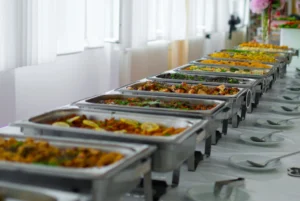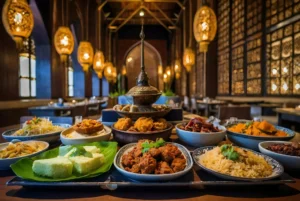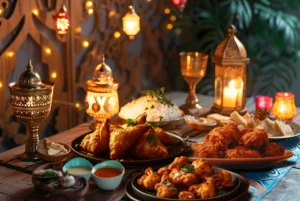Truck Art- The folk art form ruling the roads of South Asia
If you’ve ever visited Southern Asia, particularly India, Pakistan, or Bangladesh, you might have seen vibrant and elaborately painted trucks around the roads and highways of these countries. The entrancing creativity of precise floral patterns and calligraphy done on the trucks is referred to as truck art. It is an expression of the culture and traditions of these countries. So where did this form of creativity originate from? What else does it represent and what do people around the world think about these moving pieces of art?
Table of Contents
The Fascinating History of Truck Art
Every art form has a rich history that defines the origination of that piece of creativity. In Pakistan, the inception of truck art dates back to the 1920s when a moderated version of this art-form was present in the sub-continent. Initially, they appeared on trucks and Lorries that were used to move goods. They had large wooden prows on top of the truck and decorative bumpers along the cabin.
Later in the 1940s, it was adopted by Sikh truck drivers who painted vibrant portraits of their Sikh Gods and gurus as a representation of their religion and beliefs.

The Muslim truck drivers embraced this trend, by painting portraits of prominent Sufi saints on their trucks and lorries. It soon became a representation of a truck drivers’ association and attachment with their trucks. The delicacy of their work was evident by the amount of time and effort they spent on each portrait and pattern. Every craftsman had his own unique artistic style which soon amalgamated with the others.
At times, while they were all parked together at truck stops, it looked like a multi-colored scenic landscape. The truck artist used to take days and months making their trucks more captivating. Different truck drivers used to collaborate and work together on their trucks.
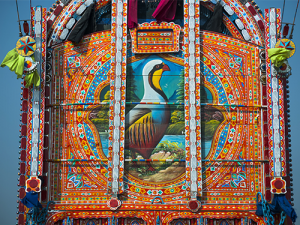
While tediously working on their trucks parked at the truck stops, they took breaks together and devoured themselves on the subcontinental cuisine. To this day, it is famous for the spices and herbs used in every dish and how they were and are still made with love and effort. It brought people from different religions together and created harmony amongst the drivers. It became a celebration of culture and tradition. The food, the craftsmanship, and the drivers from different parts of the subcontinent coming together in one place, to this day, define the cultural richness of this form of creativity.
After 1947, when Pakistan became an independent country, the truckers started adding more elements and components like peacocks and flying horses to make the artwork more appealing.
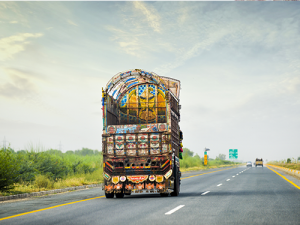
Before the 1970s the truck art was limited to portraits of significant people and spiritual images with some extra additions of cultural elements. In the early 1970s, calligraphy and floral patterns began to engulf the body of the vehicles. It was inspired by the way the billboards for Pakistani movies were painted, in a more kaleidoscopic style. This form of art first appeared on “minibuses”, a mode of transportation in Pakistan, and later was adopted by truck drivers.
By the late 1970s, international celebrities also started to appear on different trucks, like the Chinese-American martial arts expert and famous actor, Bruce Lee. By the 1980s European and American tourists, who were captivated by this art-form, took pictures of the embellished trucks and took them back to their home countries. After the government of Pakistan and the creators of truck art saw how popular the art form was becoming, they began to have truck art exhibitions abroad. Since then truck art is known as a “folk piece of creativity” from Pakistan.
The Depiction of “Folk Art-Work” Worldwide
Truck Art on a Bus in Istanbul
In 2013, a bus decorated by a Pakistani artist was unveiled in Istanbul. The unveiling was covered by the Turkish media and the people that attended were totally captivated by the mesmerizing creativity.
The artist added a few common aspects of truck art in Pakistan with some images of significant places like the Minar-e-Pakistan and Faisal Mosque alongside the Blue Mosque which somewhat symbolizes Turkey.
The Turkish media defined the truck art as the “Art of Karachi” even though the artist himself was from Lahore.
Danish Artist creating LEGO truck inspired by Pakistani Truck Art

A Danish Artist named, Adam Grabowski, created beautifully vibrant LEGO trucks. They were displayed at an exhibition and were named “ISUZU” to pay tribute and respect to the Pakistani truck drivers. Here’s an image of the vivid Lego pieces assembled to make a beautiful truck. Click here to see more of these bright and colorful images.
Students from Pakistan Gifted Australia a Truck Art Tram

Pakistan’s beautiful truck art hit the streets of Melbourne when students from Pakistan painted a local tram and gifted it to the people of Australia. The most prominent part of the artwork was the poetic one-liner “Love is life” written in both English and Urdu on the side of the bus. To see more images of this aesthetically pleasing vehicle click here.
From the roads and highways to the skies – Truck art goes airborne
Recently, in 2020, the flying academy in Pakistan painted a two-seater Cessna aircraft with elaborate floral patterns representing the cultural diversification in the country. The goal of the academy now, is to paint more aircrafts. They hired a very well-known truck artist in Pakistan, Haider Ali, who also painted Toyota FJ Cruiser in the US. Haider’s truck art has been exhibited around the world.
Beyond The Vehicles

Besides the truck art being plastered on different modes of transportation, it is used in several other things. The fashion industry at times subtly includes it to add a bit of gothic element to their collections. Sometimes restaurants around the world have truck art-inspired interior to give a more desi and cultural vibe. Truck Art is a perfect representation of desi culture just like Indian and Pakistani cuisine.
Here’s a mouthwatering dish from Laree Adda served in a traditional style. Some buttery lentils called “daalmakhni” and “karahi” served in metal cauldrons along with some flatbread (roti) on the side. Just like Truck Art this desi dish perfectly depicts and defines the desi culture of South Asia.
Truck Art-Pride of South Asia

South Asian truck art has become a global phenomenon, with exhibitions around the world and stores in posh countries selling showpieces with truck art painted over them. It has garnered the attention of many artists around the world who at times, subtly represent this art form in their work. It is one of the most culturally celebrated forms of art in Pakistan. With its elaborate designs and kaleidoscopic color schemes, it has gained popularity around the world. It’s beautiful how chaotic designs and multi-color palettes together could create something so stunningly beautiful. The effort that is put into each form of truck art goes to show the intricacy of this art form.
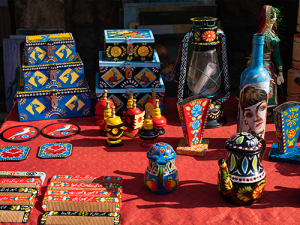
The region of South Asia is famous for how culture is represented in everything from food to buildings, to the languages and art. Every aspect somehow denotes the cultural richness of the region. The representation of this heritage can be seen around the world at desi restaurants, museums, and exhibits.
Final Word:
Laree Adda represents the cultural wealth of South Asia through the food that is served in the restaurant. From the delicious karahi to the aromatic chicken biryani, every dish is made and served with love. Try the delicious desi cuisine and dive into the vivid customs and traditions of South Asia perfectly depicted by Laree Adda.


